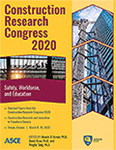Construction Research Congress 2020
Construction Workforce Challenges and Solutions: A National Study of the Roofing Sector in the United States
Publication: Construction Research Congress 2020: Safety, Workforce, and Education
ABSTRACT
Construction workforce shortage is a well-documented issue facing the built environment. Rapid rise in the number of projects, and the shortage of skilled workers are primary drivers of construction workforce shortages. Despite being less documented, the roofing industry has not been immune these challenges. In this study, current workforce challenges in the roofing industry were examined. This entailed: quantifying skilled and unskilled labor shortages, examining impacts at national and regional scales, as well as identifying potential solutions. A survey methodology was adopted to collect data from roofing contractors across the United States (n=405). Groups for regional analyses were defined based on the four census region used by the U.S. Bureau of Labor Statistics. This study suggested that labor shortages in the roofing industry are more severe than previously established. Across the United States, 90% of roofing contractors had faced labor shortages over the past year, with the West being the most severely affected. There is a shortage of both skilled and unskilled workers, and the former was more significant across all regions. Among the impacts of labor shortages, increased cost was the most dominant at both national and regional scales. The South had the highest level of subcontracting out work, and the West the lowest. Other dominant impacts included: project overruns, reduced quality of work, increased employee turnover, slowdown in business growth, etc. Attempted solutions were: wage adjustments, enhanced benefits, policy reforms, training, etc. These results merit detailed industry specific workforce studies to explore relationships with demographic and market variables. Our findings suggest that workforce challenges require strategic organizational adaption tailored to regional roofing markets.
Get full access to this article
View all available purchase options and get full access to this chapter.
ACKNOWLEDGEMENTS
This study was funded by the National Roofing Contractors Association (NRCA) and the Roofing Alliance. The study was also conducted in conjunction with these institutions.
REFERENCES
AGC (Associated General Contractors). (2016). “Two-thirds of contractors have a hard time finding qualified craft workers to hire amid growing construction demand, national survey finds.” The Associated General Contractors of America.
Albattah, M. A., Goodrum, P. M., &Taylor, T. R. (2019). “New metric of workforce availability among construction occupations and regions.” Practice Periodical on Structural Design and Construction, 24(2).
Assaf, S. A., Al-Khalil, M., &Al-Hazmi, M. (1995). “Causes of delay in large building construction projects.” Journal of management in engineering, 11(2), 45-50.
BEA (Bureau of Economic Analysis). (2018). “Value added by industry as a percentage of gross domestic product.” Bureau of Economic Analysis.
BLS (Bureau of Labor Statistics) (2002). “Health and safety statistics: Fatalities.” U.S. Department of Labor.
BLS (Bureau of Labor Statistics). (2019). “Roofing Contractors.” Occupational Employment Statistics.
Cappelli, P. H. (2015). “Skill gaps, skill shortages, and skill mismatches: Evidence and arguments for the United States.” ILR Review, 68(2), 251-290.
CPWR (The Center for Construction Research and Training). (2016). “Racial Minorities as a Worker Group in Construction and Other Industries.”
Fredericks, T. K., Abudayyeh, O., Choi, S. D., Wiersma, M., &Charles, M. (2005). “Occupational injuries and fatalities in the roofing contracting industry”. Journal of Construction Engineering and Management. 131(11), 1233-1240.
Glavin, M. (2013). “Construction projection to be the fastest growing occupation over the next 10 years.” Workforce Under Construction.
Groves, D. (2013). “Big increase in Gulf Coast projects equals big demand for skilled workers.” Construction Labor Market Analyzer.
Karimi, H., T. R. B. Taylor, P. M. Goodrum, and C. Srinivasan. (2016). “Quantitative analysis of the impact of craft worker availability on construction project safety performance.” Construction Innovation.
Olsen, D., Tatum, M., &Defnall, C. (2012). How industrial contractors are handling skilled labor shortages in the United States. 48th ASC Annual International Conference Proceedings.
Shah, C., &Burke, G. (2005). Skills shortages: concepts, measurement and policy responses. Australian Bulletin of Labour, 31(1), 44.
Vereen, S. C. (2013). “Forecasting skilled labor demand in the US construction industry.” Ph.D. dissertation, North Carolina State Univ. https://repository.lib.ncsu.edu/handle/1840.16/9124.
Watson, M. (2007). “Concerns for skills Shortages in the 21st century: A review into the construction industry, Australia.” Aust. J. Constr. Econ. Build. 7 (1): 45–54.
Information & Authors
Information
Published In
Construction Research Congress 2020: Safety, Workforce, and Education
Pages: 529 - 537
Editors: Mounir El Asmar, Ph.D., Arizona State University, David Grau, Ph.D., Arizona State University, and Pingbo Tang, Ph.D., Arizona State University
ISBN (Online): 978-0-7844-8287-2
Copyright
© 2020 American Society of Civil Engineers.
History
Published online: Nov 9, 2020
Published in print: Nov 9, 2020
Authors
Metrics & Citations
Metrics
Citations
Download citation
If you have the appropriate software installed, you can download article citation data to the citation manager of your choice. Simply select your manager software from the list below and click Download.
